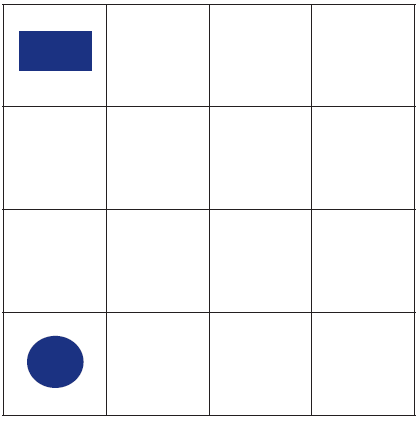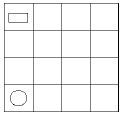This problem solving activity has a geometry focus.

Fran and David are playing with a paper circle and a paper oblong on the 4 x 4 board in the picture.
The aim of the game is to find out if the oblong and the circle can both land on the same square after 3 moves.
Fran knows her oblong can only be moved sideways, left or right, and David knows that his circle can only be moved up and down.
Both shapes move one square at a time.
Where are the shapes after three moves?
Try other starting places. Is there more than one answer?
- Give a sequence of instructions related to movement and position (forwards, backwards, sidewards, left, right).
- Devise and use problem solving strategies to explore situations mathematically (guess and check, make a drawing, use equipment).
This task requires students to interpret position and to give and follow instructions relating to direction.
- Copymaster of the problem (English)
- Copymaster of the problem (Māori)
- Oblongs and circles
- 4 x 4 grids (or a digital version of the game - e.g. on Google slides)
The Problem
Fran and David are playing with a paper circle and a paper oblong on the 4 x 4 board in the picture. The aim of the game is to find out if the oblong and the circle can both land on the same square after 3 moves.
Fran knows her oblong can only be moved sideways, left or right, and David knows that his circle can only be moved up and down. Both shapes move one square at a time.
Where are the shapes after three moves? Try other starting places. Is there more than one answer?
Teaching Sequence
- Introduce the problem as a game for 2 players. Have students understand the aim of the game.
- Each player has a shape but to move it the other player must give you instructions. This means that each player must give their partner clear instructions.
- As a class, list the words that are useful for giving instructions and directions.
- Give the students the game to play in pairs. Once more, check that the students understand that they have to give instructions for the other player to move their shape, and what they must find out.
- As the students work, ask questions that focus their thinking on the moves they are making.
What other instructions could you have given to get to this position?
Where did you start from? Where else have you started from? (if the students can't remember encourage them to plan ways to record this with a pencil mark in the square). - Ask one pair to give instructions to all the other pairs in the class about where to move the shapes so that they land on one another.
Are there any other solutions? - Discuss how they checked out other possibilities.
Extension
Make up movement rules for a new game using the grid.
Solution
After 3 moves (if they continue to move in the same direction) the oblong lands in the top right-hand square and the circle lands in the top left-hand square.
If the oblong starts out in any of the four corner squares of the board, then the circle can be positioned to join it on their third moves.
